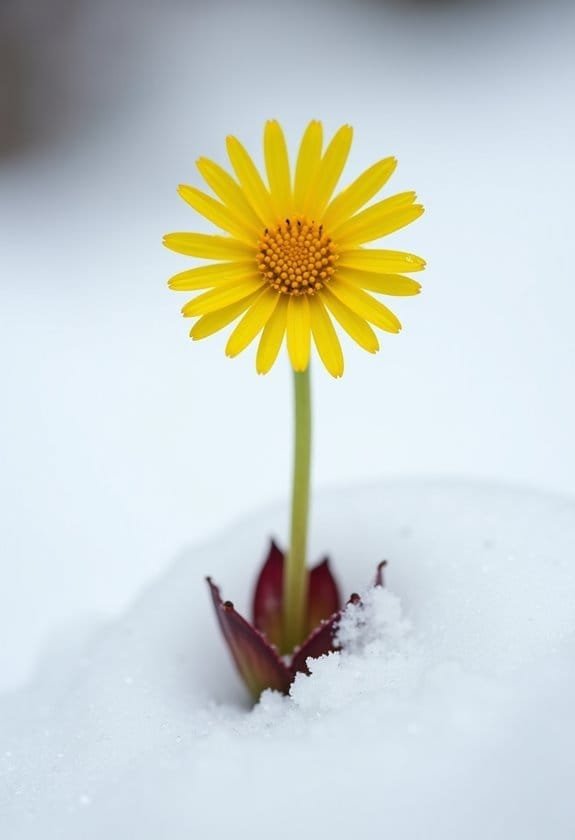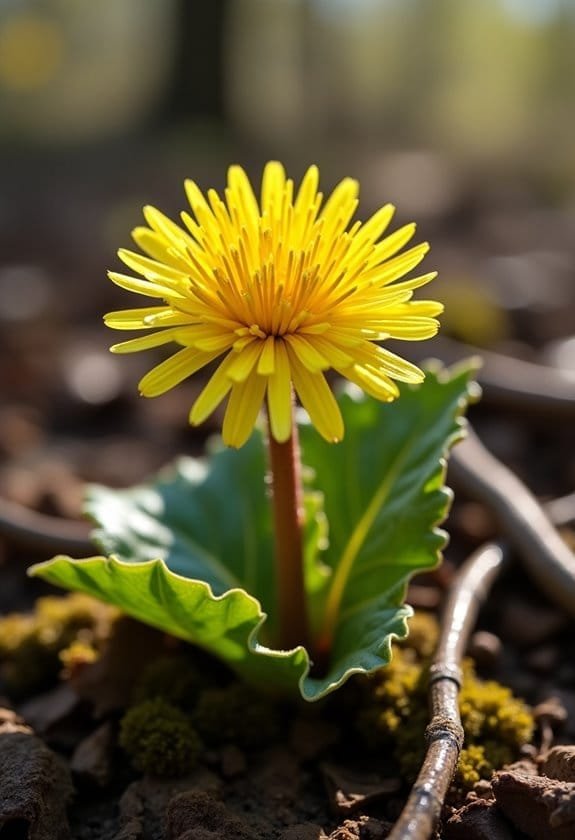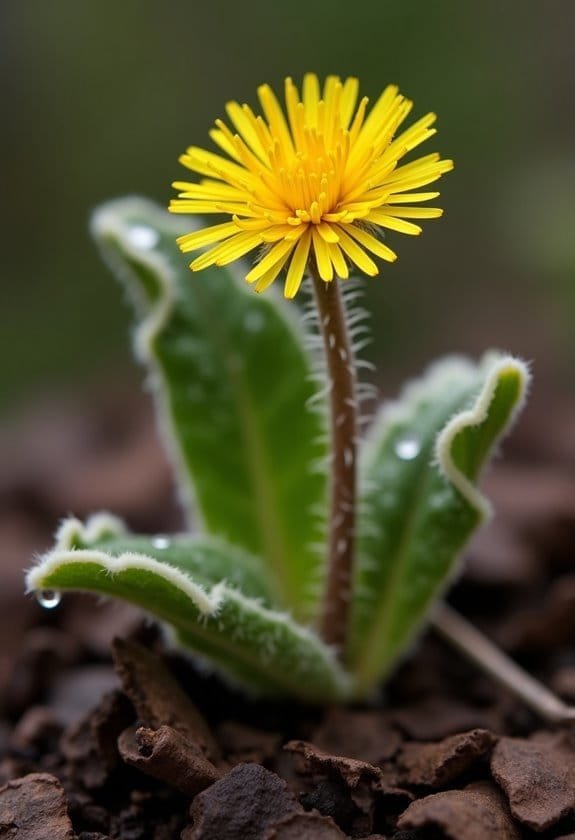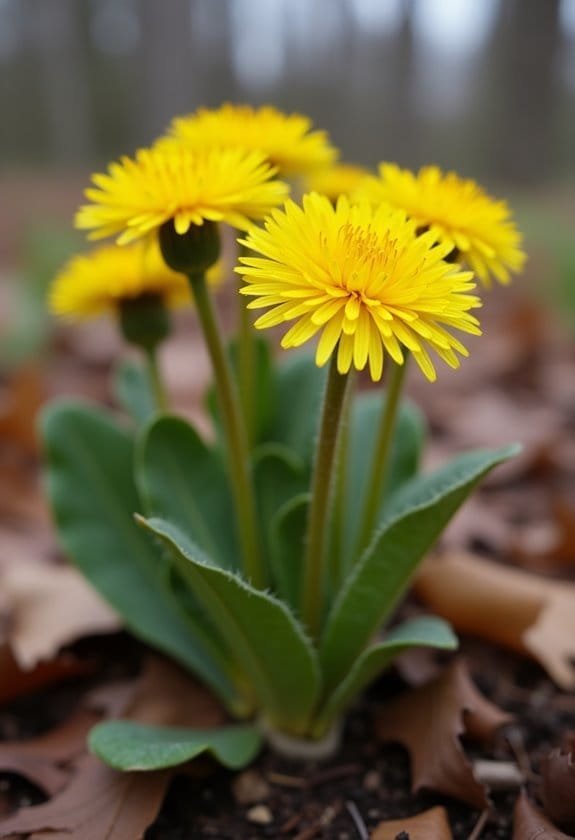Coltsfoot (Tussilago farfara) is a resilient perennial herb that's well-known for its unique flowering pattern, producing bright yellow, dandelion-like blooms before its leaves emerge in early spring. Its heart-shaped leaves, measuring 2 to 8 inches long, appear after the flowers fade, while its extensive underground rhizome network enables rapid colonization of disturbed areas. The plant's height ranges from 2 to 20 inches, and each flower head can produce up to 1,000 wind-dispersed seeds, traveling up to 8 miles. This adaptable species thrives in various soil types and serves as a vital early-season resource for pollinators, though its aggressive growth patterns warrant careful management to prevent unwanted spread. Understanding coltsfoot's dual nature as both beneficial pollinator plant and potential invasive reveals its complex role in modern ecosystems.
Main Points
- Coltsfoot is a perennial herb with yellow flowers that bloom before leaves appear, known historically for treating respiratory conditions.
- The plant belongs to the Asteraceae family and grows 2-20 inches tall with heart-shaped leaves measuring 2-8 inches long.
- Each plant produces thousands of wind-dispersed seeds and spreads through underground rhizomes, making it potentially invasive.
- Coltsfoot thrives in full sunlight and various soil types, preferring moist conditions and often colonizing disturbed areas.
- Early spring blooms make it valuable for pollinators, particularly honeybees emerging after winter.
Introduction

Coltsfoot (Tussilago farfara), a resilient perennial herb with distinctive yellow flowers, has established itself across Europe, western Asia, and North America since its introduction in the 1840s.
Its name derives from the unique shape of its leaves, which ancient herbalists likened to a colt's hoof, reflecting both its physical appearance and historical significance in traditional medicine.
The plant's remarkable ability to produce flowers before leaves emerge in early spring, combined with its extensive underground rhizome network, has enabled it to become a significant presence in various ecosystems, though sometimes raising concerns about its invasive potential.
Common Name
Recognition of this medicinal herb comes from its distinctive leaf shape, which resembles a young horse's foot. This physical characteristic directly influenced its common name "coltsfoot," derived from the medieval Latin term "pes pulli," meaning foal's foot. The plant's visual similarity to equine hooves has been a consistent identifier throughout history.
The plant's medicinal properties have also influenced its nomenclature, particularly evident in names like "coughwort," which reflects its traditional use in treating respiratory conditions. In ancient Greek, the term "bechion," meaning cough, further emphasizes this historical medical connection. The name's evolution demonstrates how closely linked the plant's appearance and therapeutic uses have become in various cultures.
Interestingly, coltsfoot's unique flowering pattern, where blossoms appear before leaves in early spring, has contributed to its widespread recognition. This distinctive characteristic helps distinguish it from similar-looking species, particularly Petasites frigidus (western coltsfoot), though confusion between these plants still occurs.
The multiple colloquial names, including "horse foot" and "tash plant," illustrate the plant's cultural significance across different regions.
Scientific Name
In scientific classification, Tussilago farfara stands as the taxonomic designation for coltsfoot, placing it within the expansive Asteraceae family. This nomenclature derives from medieval Latin "pes pulli," reflecting the distinctive hoof-like shape of the plant's leaves, which has intrigued botanists for centuries.
The genus Tussilago represents a remarkably selective taxonomic group, with Tussilago farfara emerging as its most prominent member. While the plant's scientific classification anchors it firmly within the diverse aster family, which includes thousands of flowering species worldwide, its unique characteristics set it apart from its botanical relatives.
The species has garnered significant attention in botanical circles, particularly as an invasive species in regions beyond its natural habitat.
The scientific name encapsulates both the plant's physical attributes and its historical significance, with "Tussilago" referencing its traditional medicinal applications for coughs, while "farfara" relates to the ancient term for the plant.
This binomial nomenclature provides researchers and botanists with a standardized way to discuss and study this remarkable plant across different languages and cultures.
Overview
Beyond its scientific classification, Tussilago farfara stands as one of Europe's most distinctive medicinal herbs, known commonly as coltsfoot. This resilient perennial has established itself as both a beneficial and potentially concerning species since its introduction to the northeastern United States in the 1840s.
Coltsfoot's unique flowering pattern sets it apart from many other plants, as its bright yellow blooms emerge before its leaves in early spring, producing hundreds to thousands of seeds per flower head.
While initially valued for its therapeutic properties, the plant has demonstrated invasive tendencies, readily colonizing disturbed areas such as roadsides, riverbanks, and wetland margins where moisture and sunlight are abundant.
The plant's ecological role is particularly significant, as it serves as an essential early-season nectar source for honeybees and supports specific lepidopteran species.
However, its presence in modern herbal medicine has become controversial due to the discovery of pyrrolizidine alkaloids within its tissues, leading to increased regulatory oversight and restrictions on its use in various countries.
Key Features
Coltsfoot stands out as a modest-sized plant, growing between 2 to 20 inches in height, with heart-shaped leaves that stretch 2 to 8 inches long in a basal rosette pattern.
Its bright yellow flower heads, measuring 1 to 1.25 inches wide, emerge in early spring before the leaves appear, making it a distinctive sight among dormant vegetation.
The plant's remarkable reproductive capabilities include both vegetative spread through rhizomes and prolific seed production, with each plant generating 3,500 to 4,600 seeds that can travel up to 8 miles on wind currents.
Growth Size
A striking characteristic of this perennial herb is its variable height, ranging from 2 to 20 inches tall, while its bright yellow flowers span 1 to 1.25 inches across. In early spring, these dandelion-like blooms emerge before the distinctive heart-shaped leaves make their appearance, creating a unique growth pattern.
The plant's growth size is particularly remarkable due to its vigorous underground rhizome system, which enables rapid expansion across suitable terrain. Its basal leaves, measuring 2 to 8 inches in length, form dense rosettes and feature a distinctive white, fuzzy underside that sets them apart from similar species.
The plant's reproductive capabilities are equally impressive, producing tiny achenes that measure just 0.1 to 0.2 inches long, which can travel up to 8 miles on wind currents. Under ideal conditions, coltsfoot demonstrates remarkable spreading potential, with established patches extending their reach by 8.2 to 11.5 feet within a mere two-year period, making it a significantly successful colonizer in various habitats.
Appearance
The most striking visual feature of Tussilago farfara lies in its bright yellow flowers, which emerge on hairy stems before any leaves appear in early spring. These dandelion-like blooms measure 1 to 1.25 inches in width and create a distinctive splash of color in the early spring landscape, composed of both disc and ray florets arranged in a sunny display.
The plant's appearance undergoes a notable transformation throughout its growing cycle, with flowering stems emerging first, covered in distinctive hairlike structures.
After blooming, the heart-shaped leaves develop into a basal rosette, spanning 2 to 8 inches in length, with a remarkable white, fuzzy underside that sets them apart from similar species. This dual-stage growth pattern creates an interesting visual evolution, where the plant's appearance changes dramatically from its flowering to its leafing phase.
When the flowers mature, they produce seeds that mirror the familiar structure of dandelion seeds, measuring between 0.1 to 0.2 inches in length, creating a delicate, windborne dispersal system that adds to the plant's ephemeral charm.
Flowering Season
During early spring, when most plants remain dormant, flowering stems of Tussilago farfara emerge as solitary stalks, each bearing a bright yellow flower head that measures up to 1.25 inches wide. These distinctive flower heads, reminiscent of miniature dandelions, appear before the plant's leaves develop, creating a striking presence in the landscape.
The flowering stems are particularly notable for their adaptive behaviors, as they're covered in protective woolly hairs and respond to environmental conditions by closing at night and during cloudy weather. This characteristic made the plant easily recognizable to early settlers seeking the first signs of spring.
Each flower head demonstrates remarkable reproductive potential, producing between 100 to 1,000 seeds, with wild populations typically generating 157-178 seeds per head. The plant's strategic early flowering period serves an essential ecological function, providing vital nectar resources for honeybees and other pollinators when alternative food sources are scarce.
This timing guarantees successful pollination and seed production before most other spring-flowering species begin their annual cycle.
Growing Requirements

Coltsfoot thrives in full sunlight with light intensity above 60%, making it an excellent colonizer of open, disturbed areas like roadsides and stream banks.
The plant demonstrates remarkable adaptability to various soil compositions, including clays, silts, loams, and sands, though it particularly favors consistently moist, well-aerated conditions for ideal growth.
Its ability to flourish across different environments stems from its extensive rhizomatous root system, which enables rapid expansion of up to 11.5 feet in just two years when temperature and moisture conditions are favorable.
Light
Under ideal growing conditions, this medicinal herb requires full sunlight for robust development. Coltsfoot demonstrates remarkable adaptability to various environments, yet it clearly flourishes in open areas where direct sunlight can reach its broad, distinctive leaves.
The plant's growth patterns show a strong correlation between light intensity and overall vigor, particularly when combined with moist soils. Research indicates that reduced light conditions of 60%-70% intensity can greatly impair seedling development, highlighting the plant's inherent need for bright exposure.
While coltsfoot can survive in partially shaded locations, its growth becomes noticeably stunted, and its ability to reproduce through vegetative means diminishes considerably. In high-density areas where light penetration is limited, the plant's survival rate drops markedly, affecting both its medicinal properties and structural integrity.
For ideal cultivation, gardeners should select locations that receive abundant sunlight throughout the growing season, as these conditions most closely mirror the plant's natural habitat preferences and support its characteristic vigorous growth patterns.
Soil
The growing requirements for soil complement coltsfoot's need for bright sunlight, as this adaptable plant successfully establishes itself in diverse soil compositions. From dense clays to well-draining sands, coltsfoot demonstrates remarkable versatility in its ability to colonize various substrates, though it shows a distinct preference for consistently moist conditions.
In fertile environments, coltsfoot's vegetative reproduction capabilities reach their full potential through enhanced rhizome development. The plant's underground network expands more aggressively in nutrient-rich soils, enabling rapid colonization of suitable habitats.
Soil disturbance actually benefits this opportunistic species, as disrupted terrain creates ideal conditions for both seedling establishment and rhizomatous spread.
The relationship between soil moisture and aeration plays a vital role in coltsfoot's success, particularly during the vulnerable seedling stage. When water availability drops below ideal levels, young plants struggle to survive, emphasizing the importance of adequate soil hydration.
This moisture dependency, combined with the plant's ability to thrive in various soil types, explains its frequent appearance in disturbed, damp areas where other species might struggle to establish themselves.
Water
Maintaining consistent moisture levels proves critical for coltsfoot's successful growth and reproduction, particularly in areas with full sunlight exposure. The plant's natural habitat preferences reflect its strong affinity for water-rich environments, where it's commonly found thriving along streambanks and in wetland areas that provide ideal growing conditions.
While coltsfoot demonstrates some adaptability to varying moisture conditions, its vegetative reproduction system performs most effectively in consistently moist soils. The plant's extensive network of rhizomes efficiently colonizes disturbed areas when adequate moisture is present, allowing for rapid establishment of new populations.
Seedling establishment depends heavily on sufficient water availability, as young plants struggle to survive in drought conditions. In environments where multiple species compete for resources, coltsfoot's water requirements become even more pronounced, often leading to stunted growth when moisture is limited.
For ideal cultivation, gardeners should maintain steady soil moisture without creating waterlogged conditions that might compromise root aeration, thereby mimicking the plant's natural habitat preferences in low-lying areas.
Temperature
Successfully cultivating coltsfoot depends heavily on providing appropriate temperature conditions throughout its growth cycle. The plant exhibits ideal seed germination within a specific temperature range of 50°F to 77°F (10°C to 25°C), which creates an ideal environment for establishing new growth.
Temperature plays a significant role in coltsfoot's distinctive growth pattern, particularly during early spring when the plant produces flowers before its leaves fully emerge. This unique adaptation allows the plant to take advantage of warming temperatures while maximizing sunlight exposure through the still-bare tree canopy.
In conjunction with temperature requirements, coltsfoot demonstrates robust growth in moist soils where temperature fluctuations are moderated by adequate moisture content.
The plant's temperature sensitivity extends to its seedling development phase, where consistent warmth promotes healthy establishment. When temperatures fall outside the ideal range, seedlings may experience stunted growth or delayed development, especially if combined with reduced light intensity.
Understanding these temperature requirements helps gardeners and botanists create favorable conditions that support coltsfoot's natural growth cycle.
Pollinator Criteria
Coltsfoot's bright yellow flowers serve as a vital early-spring food source for honeybees, providing essential pollen and nectar when few other flowering plants are available.
The plant's flowering period from March to April creates an important bridge for pollinators emerging from winter dormancy, especially in disturbed areas where alternative food sources may be scarce.
While honeybees are the primary pollinators, other beneficial insects visit coltsfoot's flowers, which produce hundreds to thousands of wind-dispersed seeds per flower head, contributing to both pollinator support and plant propagation.
Attracted Pollinators
The bright yellow blooms of coltsfoot serve as beacons for early spring pollinators, particularly honeybees seeking sustenance after winter dormancy. These flowers, which emerge before the plant's leaves develop, provide a vital nutritional lifeline during a period when food sources are especially scarce in the ecosystem.
What makes coltsfoot particularly valuable to pollinators is its strategic flowering pattern, which guarantees unobstructed access to its nectar-rich blossoms. The plant's dandelion-like flowers produce abundant nectar and pollen, creating an irresistible attraction for honeybees emerging from their winter clusters. This timing is especially essential for colony survival and early spring foraging success.
While honeybees are the primary beneficiaries of coltsfoot's early bloom cycle, the plant also attracts other insect species, contributing to the broader pollinator network.
The relationship between coltsfoot and its pollinators exemplifies a perfectly timed ecological partnership, where the plant's flowering schedule aligns with the vital nutritional needs of early-emerging insects, particularly honeybees rebuilding their energy reserves after winter.
Pollination Method
While early spring pollinators flock to coltsfoot flowers, a sophisticated pollination system guarantees reproductive success through both cross-pollination and self-pollination mechanisms. The plant's primary strategy relies on cross-pollination facilitated by insects, particularly bees, which are drawn to the abundant nectar and pollen reserves within the flower heads.
The timing of pollination is strategically synchronized with the emergence of early-season pollinators, as coltsfoot flowers bloom before their leaves appear. This reproductive strategy maximizes the plant's chances of successful pollination during a period when fewer competing plants are in flower.
The effectiveness of this pollination method is evident in the substantial seed production, with individual flower heads generating between 100 to 1,000 seeds, averaging 157-178 seeds in wild populations. The quality of pollination directly influences seed viability and subsequent seed dispersal, which primarily occurs through wind distribution.
When cross-pollination isn't possible due to limited pollinator activity, the plant's ability to self-pollinate serves as a backup mechanism, ensuring the continuation of the species even under challenging environmental conditions.
Care & Maintenance

Successful cultivation of coltsfoot requires careful attention to planting conditions, with an emphasis on moist, well-drained soils and proper spacing between specimens to prevent overcrowding.
Regular maintenance practices, including consistent watering during dry periods and early spring fertilization with a balanced nutrient mix, help guarantee vigorous growth and abundant flowering throughout the season.
When selecting companion plants, gardeners should consider species that thrive in similar conditions while avoiding aggressive spreaders that might compete with coltsfoot for essential resources.
Planting Tips
Growing coltsfoot successfully requires attention to key planting fundamentals. The plant's natural affinity for moist, well-drained soils makes it particularly well-suited for disturbed areas like roadsides and stream banks, where it can establish robust colonies in full sunlight.
When implementing planting tips for coltsfoot, proper rhizome placement is essential for ideal growth. Gardeners should position rhizomes approximately one inch beneath the soil surface, which allows for efficient nutrient absorption and promotes vigorous vegetative spread.
While the plant's hardy nature typically eliminates the need for fertilization, incorporating organic matter can boost growth in less fertile environments.
To prevent invasive spread and maintain healthy plant density, regular monitoring becomes imperative. As coltsfoot establishes itself, adequate water provision plays an important role, especially during dry spells when young plants are most vulnerable.
Gardeners should remain vigilant about thinning overcrowded patches, ensuring each plant has sufficient space to develop its characteristic yellow blooms and broad leaves without overwhelming neighboring vegetation.
Ongoing Care
After establishing coltsfoot in your garden, maintaining proper care practices guarantees its long-term health and prevents unwanted spread. Regular monitoring of soil moisture levels is vital, as these adaptable plants thrive in consistently damp conditions that mirror their natural habitat preferences.
To control coltsfoot's vigorous growth pattern, gardeners must stay vigilant about its rhizomatous spreading tendency. This involves carefully observing and managing the plant's underground stems, which can quickly colonize surrounding areas if left unchecked.
The removal of spent flower heads immediately after blooming serves as a significant maintenance task to prevent self-seeding and maintain garden boundaries.
Light management plays a considerable role in coltsfoot care, requiring gardeners to ascertain adequate sunlight exposure by removing encroaching vegetation that might cast unwanted shade.
For those interested in using coltsfoot for herbal remedies, it's important to exercise caution and source materials only from certified suppliers who test for pyrrolizidine alkaloid levels. This careful approach to cultivation balances the plant's beneficial properties with necessary safety considerations, safeguarding both garden health and user well-being.
Suggested Companions
Plant compatibility plays an essential role when selecting companions for coltsfoot gardens. When choosing companion plants, gardeners should focus on moisture-loving species that thrive in similar growing conditions, particularly those adapted to damp, disturbed soils.
Ferns make excellent partners, as they share coltsfoot's preference for consistently moist environments and partial shade conditions.
While coltsfoot can grow in full sun locations, careful consideration must be given to its potentially invasive nature. To create a harmonious garden ecosystem, pair it with robust perennials that won't be easily overwhelmed by coltsfoot's spreading tendency.
Moisture-tolerant wildflowers, such as marsh marigolds and meadowsweet, can coexist successfully when proper maintenance routines are established. Regular pruning of spent flower stalks helps manage coltsfoot's growth and prevents it from dominating its companions.
The key to successful companion planting lies in matching soil preferences. Plants that flourish in clay or loam soils with good moisture retention will partner well with coltsfoot, creating a cohesive planting scheme that supports the health of all species involved.
What Are the Differences Between Coltsfoot and Stinking Chamomile in Herbal Uses?
Coltsfoot is commonly used for respiratory ailments due to its soothing properties, while stinking chamomile is known for its digestive and anti-inflammatory benefits. For a complete stinking chamomile plant overview and information, this herb also carries a strong odor, distinguishing it from coltsfoot in both aroma and specific traditional applications.
Common Issues
While coltsfoot is generally resilient, it can fall prey to leaf-spotting fungi and various soil-borne pathogens that create dark lesions on its foliage.
Common pests include slugs and snails, which target young shoots and can greatly damage emerging spring growth in damp conditions.
Effective management typically involves improving air circulation around plants, removing infected foliage promptly, and applying organic slug deterrents such as diatomaceous earth during vulnerable growth periods.
Pests/Diseases
Despite its hardy nature, coltsfoot can fall prey to several pests and diseases that may compromise its health.
Root rot emerges as a primary concern when the plant's growing conditions include excessive moisture or poorly draining soil, which can severely damage the root system and impair nutrient uptake.
In humid environments, fungal infections like powdery mildew can establish themselves on the plant's foliage, manifesting as distinctive white, powder-like patches that gradually spread across leaf surfaces.
Leaf spot diseases present another challenge, creating dark, irregular blemishes that can greatly reduce the plant's photosynthetic capacity and overall vigor.
Among the pest concerns, aphids and other sap-feeding insects pose a notable threat to coltsfoot's well-being, as their feeding activities can lead to leaf distortion and general plant weakness.
While these issues might seem intimidating, regular monitoring combined with appropriate cultural practices, such as proper spacing for air circulation and careful water management, can effectively prevent or minimize the impact of most pests and diseases on coltsfoot populations.
Solutions
Addressing common issues with coltsfoot requires a systematic approach for management and control. Effective management strategies focus on preventing its spread through both seed dispersal and rhizome growth, particularly in areas where soil disturbance has created favorable conditions for colonization.
Regular monitoring of susceptible sites enables early detection and swift intervention before colonies become established.
To control existing populations, a combination of mechanical and cultural methods proves most effective. Removing entire root systems before seed production occurs helps prevent both vegetative spread and seed dispersal, while careful rehabilitation of disturbed areas with native species can reduce opportunities for coltsfoot invasion.
Sites must be inspected regularly, as the plant's aggressive growth means overlooked rhizome fragments can quickly regenerate.
When implementing control measures in areas where coltsfoot has medicinal uses, it's crucial to take into account the plant's pyrrolizidine alkaloid content and comply with relevant regulatory requirements.
Successful management often requires a long-term commitment to site maintenance and the establishment of competitive vegetation that can naturally suppress coltsfoot's growth potential.
Summary

Coltsfoot's distinctive yellow flowers and heart-shaped leaves make it a recognizable perennial herb across Europe, Asia, and North America. Originally introduced as a medicinal plant in the early 19th century, this invasive species has demonstrated remarkable adaptability and reproductive capabilities in its new environments.
The plant's biological characteristics make it a formidable colonizer, producing an impressive 3,500 to 4,600 seeds per plant that can travel up to 8 miles on wind currents.
While its early spring blooms might appear harmless, Coltsfoot's aggressive spread poses significant challenges to native ecosystems, particularly in disturbed areas and along waterways. The plant's presence isn't just an ecological concern; it also presents notable health risks due to its pyrrolizidine alkaloids, which have led to regulatory actions such as Germany's ban on its sale.
Understanding Coltsfoot's dual nature as both a traditional medicinal herb and a potentially harmful invasive species highlights the complex relationships between introduced plants and their adopted environments, serving as a reminder of the careful consideration needed when introducing non-native species to new regions.


